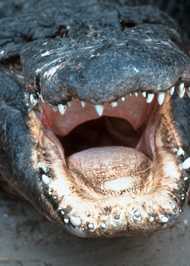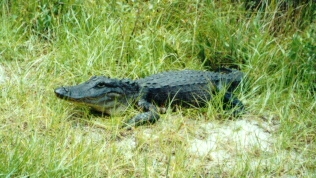![]()
What is an Alligator ?


.
What kind of animal is it?
| Class: Reptiles | |
| Order: Crocodilia Order Crocodilia is comprised of 3 families: (1)Alligatoridae - American and Chinese alligators and caimans. (2) Crocodylidae - Crocodiles. (3) Gavialidae - gavials. | |
| Family: Alligatoridae | |
| Species: Alligator mississipiensis, (Other species are : Alligator sinensis, Caiman crocodilus) |
Name: American alligator
Where does it live?
| Place: Southeastern United States coast from North Carolina to East Texas | |
| Habitat: Fresh to mildly brackish water | |
| Needs a good water source for breeding | |
| Requires a land source for shade, shelter and sunning |
What does it eat?
| Alligators are not fussy about what they eat; it can be dead or alive. | |
| They eat insects, crustaceans, fish, frogs, snakes, waterfowl, and small mammals. Adults may eat dogs, cattle and other large mammals. |
What does it looks like?
| Snout is long and wider than that of a crocodile | |
| Teeth don't show and it cannot stick its tongue out | |
| Top of animal is a shade of olive green or brown; the underside is cream or yellow. | |
| Animal has four short legs, webbed feet and a long powerful tail. |
How big are American alligators?
| Adult females: 6 to 8 feet long | |
| Adult males: 8 to 10 feet long |
What are its enemies and threats?
| Raccoons, bears, otters, turtles, fish and herons eat alligator eggs and young. | |
| Probably only 10-20% survive the first 3 years. | |
| Humans are the only enemy of adult alligators. |
How does it protect itself and/or adapt to its environment?
| Eyes, ears, and nostrils are on top of its head for breathing in water. | |
| It can be nearly submerged in water and still breathe. | |
| Strong tail and swimming capability are protection. |
What are other facts?
| Male uses its voice, "bellowing", when it is fighting for a mate. | |
| A young alligator uses a high-pitched sound to alert adults if they are in danger. |
Does it have any other names?
| Gator |
Is it endangered? From 1967 to 1977 American Alligators were considered endangered. Now they are listed as threatened.
Reason: At first, animals were sold for leather and as pets. Now, habitat destruction and hunting threaten them.
Resources
Information adapted from:
Chaffee Zoological Gardens WebsiteMore information on:
Crocodilians: Natural History and Conservation
![]()
 /
/